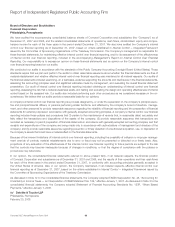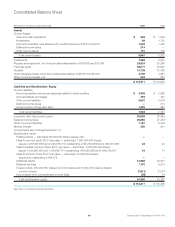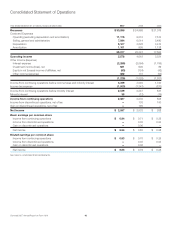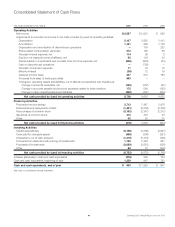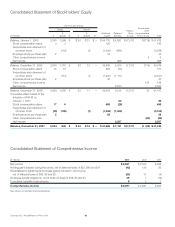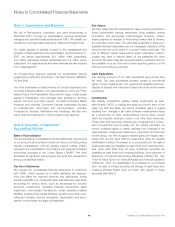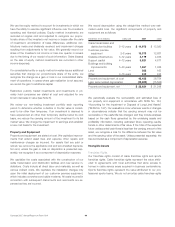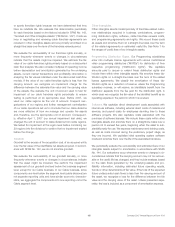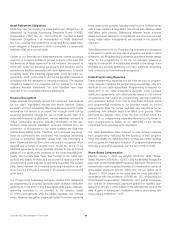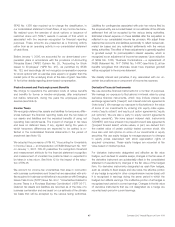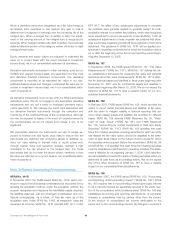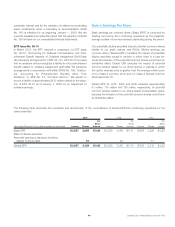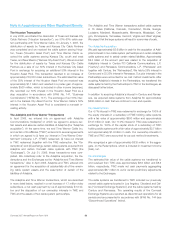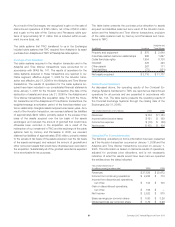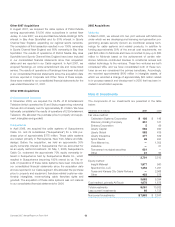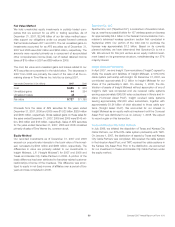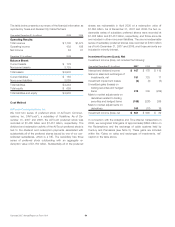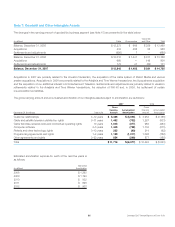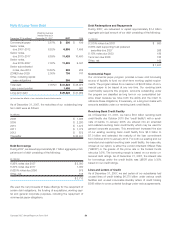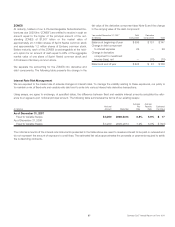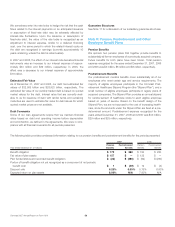Comcast 2007 Annual Report Download - page 50
Download and view the complete annual report
Please find page 50 of the 2007 Comcast annual report below. You can navigate through the pages in the report by either clicking on the pages listed below, or by using the keyword search tool below to find specific information within the annual report.
When a derivative instrument designated as a fair value hedge is
terminated, sold, exercised or has expired, any gain or loss is
deferred and recognized in earnings over the remaining life of the
hedged item. When a hedged item is settled or sold, the adjust-
ment in the carrying amount of the hedged item is recognized in
earnings. When hedged variable-rate debt is settled, the previously
deferred effective portion of the hedge is written off similar to debt
extinguishment costs.
Equity warrants and equity collars are adjusted to estimated fair
value on a current basis with the result included in investment
income (loss), net in our consolidated statement of operations.
Derivative instruments embedded in other contracts, such as our
ZONES and prepaid forward sales, are separated into their host
and derivative financial instrument components. The derivative
component is recorded at its estimated fair value in our con-
solidated balance sheet and changes in estimated fair value are re-
corded in investment income (loss), net in our consolidated state-
ment of operations.
All derivative transactions must comply with our Board-authorized
derivatives policy. We do not engage in any speculative derivative
transactions and are not a party to leveraged derivative instru-
ments (see Note 8). We manage the credit risks associated with
our derivative financial instruments through the evaluation and
monitoring of the creditworthiness of the counterparties. Although
we may be exposed to losses in the event of nonperformance by
the counterparties, we do not expect such losses, if any, to be
significant.
We periodically examine the instruments we use to hedge ex-
posure to interest rate and equity price risks to ensure that the
instruments are matched with underlying assets or liabilities, re-
duce our risks relating to interest rates or equity prices and,
through market value and sensitivity analysis, maintain a high
correlation to the risk inherent in the hedged item. For those
instruments that do not meet the above criteria, variations in their
fair value are reflected on a current basis in our consolidated state-
ment of operations.
Note 3: Recent Accounting Pronouncements
SFAS No. 141R
In November 2007, the FASB issued SFAS No. 141R, which con-
tinues to require that all business combinations be accounted for by
applying the acquisition method. Under the acquisition method, the
acquirer recognizes and measures the identifiable assets acquired,
the liabilities assumed, and any contingent consideration and con-
tractual contingencies, as a whole, at their fair value as of the
acquisition date. Under SFAS No. 141R, all transaction costs are
expensed as incurred. SFAS No. 141R rescinds EITF 93-7. Under
EITF 93-7, the effect of any subsequent adjustments to uncertain
tax positions were generally applied to goodwill, except for post-
acquisition interest on uncertain tax positions, which was recognized
as an adjustment to income tax expense. Under SFAS No. 141R, all
subsequent adjustments to these uncertain tax positions that other-
wise would have impacted goodwill will be recognized in the income
statement. The guidance in SFAS No. 141R will be applied pro-
spectively to business combinations for which the acquisition date is
on or after the beginning of the first annual reporting period begin-
ning after December 15, 2008.
SFAS No. 157
In September 2006, the FASB issued SFAS No. 157, “Fair Value
Measurements” (“SFAS No. 157”). SFAS No. 157 defines fair val-
ue, establishes a framework for measuring fair value and expands
disclosure about fair value measurements. SFAS No. 157 is effec-
tive for financial assets and liabilities in fiscal years beginning after
November 15, 2007 and for nonfinancial assets and liabilities in
fiscal years beginning after March 15, 2008. We do not expect the
adoption of SFAS No. 157 to have a material impact on our con-
solidated financial statements.
SFAS No. 159
In February 2007, FASB issued SFAS No. 159, which provides the
option to report certain financial assets and liabilities at fair value,
with the intent to mitigate volatility in financial reporting that can
occur when related assets and liabilities are recorded on different
bases. SFAS No. 159 amends FASB Statement No. 95, “State-
ment of Cash Flows” (“SFAS No. 95”) and FASB Statement
No. 115, “Accounting for Certain Investments in Debt and Equity
Securities” (“SFAS No. 115”). SFAS No. 159 specifies that cash
flows from trading securities, including securities for which an entity
has elected the fair value option, should be classified in the state-
ment of cash flows based on the nature of and purpose for which
the securities were acquired. Before this amendment, SFAS No. 95
and SFAS No. 115 specified that cash flows from trading securities
must be classified as cash flows from operating activities. This state-
ment is effective for us beginning January 1, 2008. Upon adoption,
we will reclassify proceeds from sales of trading securities within our
statement of cash flows as an investing activity. We do not expect
any of the other provisions of SFAS No. 159 to have a material
impact on our consolidated financial statements.
SFAS No. 160
In November 2007, the FASB issued SFAS No. 160, “Accounting
and Reporting of Noncontrolling Interest” (“SFAS No. 160”). SFAS
No. 160 requires that a noncontrolling interest (previously referred
to as a minority interest) be separately reported in the equity sec-
tion of the consolidated entity’s balance sheet. SFAS No. 160 also
established accounting and reporting standards for: (i) ownership
interests in subsidiaries held by parties other than the parent,
(ii) the amount of consolidated net income attributable to the
parent and to the noncontrolling interest, (iii) changes in a parent’s
Comcast 2007 Annual Report on Form 10-K 48


